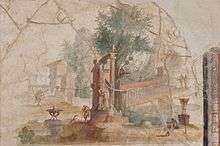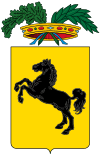Boscotrecase
| Boscotrecase | |
|---|---|
| Comune | |
| Comune di Boscotrecase | |
 Boscotrecase Location of Boscotrecase in Italy | |
| Coordinates: 40°47′N 14°28′E / 40.783°N 14.467°ECoordinates: 40°47′N 14°28′E / 40.783°N 14.467°E | |
| Country | Italy |
| Region | Campania |
| Metropolitan city | Naples (NA) |
| Government | |
| • Mayor | Pietro Carotenuto |
| Area | |
| • Total | 7.5 km2 (2.9 sq mi) |
| Elevation | 86 m (282 ft) |
| Population (30 November 2015) | |
| • Total | 10,339 |
| • Density | 1,400/km2 (3,600/sq mi) |
| Demonym(s) | Boschesi |
| Time zone | UTC+1 (CET) |
| • Summer (DST) | UTC+2 (CEST) |
| Postal code | 80042 |
| Dialing code | 081 |
| Patron saint | St. Anne |
| Saint day | 26 July |
| Website | Official website |
Boscotrecase (Italian pronunciation: [boskotreˈkaːze]; Neapolitan: Vuoschetreccàse) is a comune (municipality) in the Metropolitan City of Naples in the Italian region Campania, located about 20 km southeast of Naples.
It is best known for the elite ancient Roman works of art[1] excavated from the Villa of Agrippa Postumus, also known as the Imperial Villa or the Villa of Augusta, which was buried by Vesuvius in 79 AD.[2]

The frescoes from the villa are masterpieces and some of the finest examples of Roman wall painting. Of many ancient Roman villas that were built along the coast of the Bay of Naples, this was one of the most sumptuous. It was built by Agrippa, general and right-hand man of Emperor Augustus and husband of his daughter Julia. The villa passed came into ownership of his posthumously born infant son, Agrippa Postumus, in 11 B.C and Julia would have overseen the completion of the villa.
The frescoes were removed by the excavators and are now shared between the Metropolitan Museum of Art.[3] and the National Archaeological Museum of Naples.

Discovery
This large villa was accidentally discovered in 1903 when the Circumvesuviana railway line was under construction. The landowner excavated it until 1905 with the help of the Italian archaeologist, Matteo Della Corte. The villa was re-buried by lava during the eruption in April 1906.
References
External links
